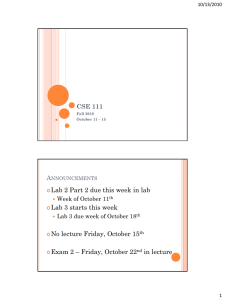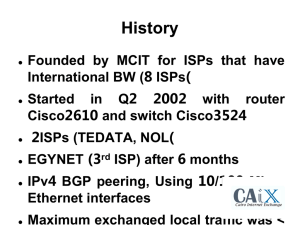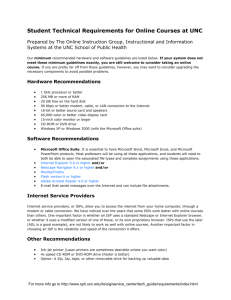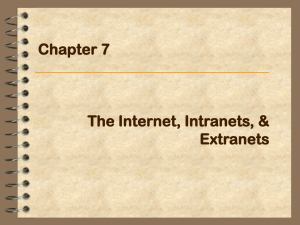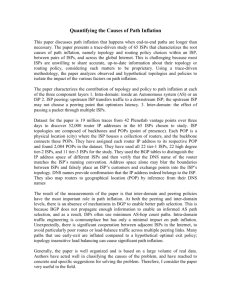2015 VOLUNTARY CODE OF PRACTICE: BROADBAND SPEEDS Contents
advertisement
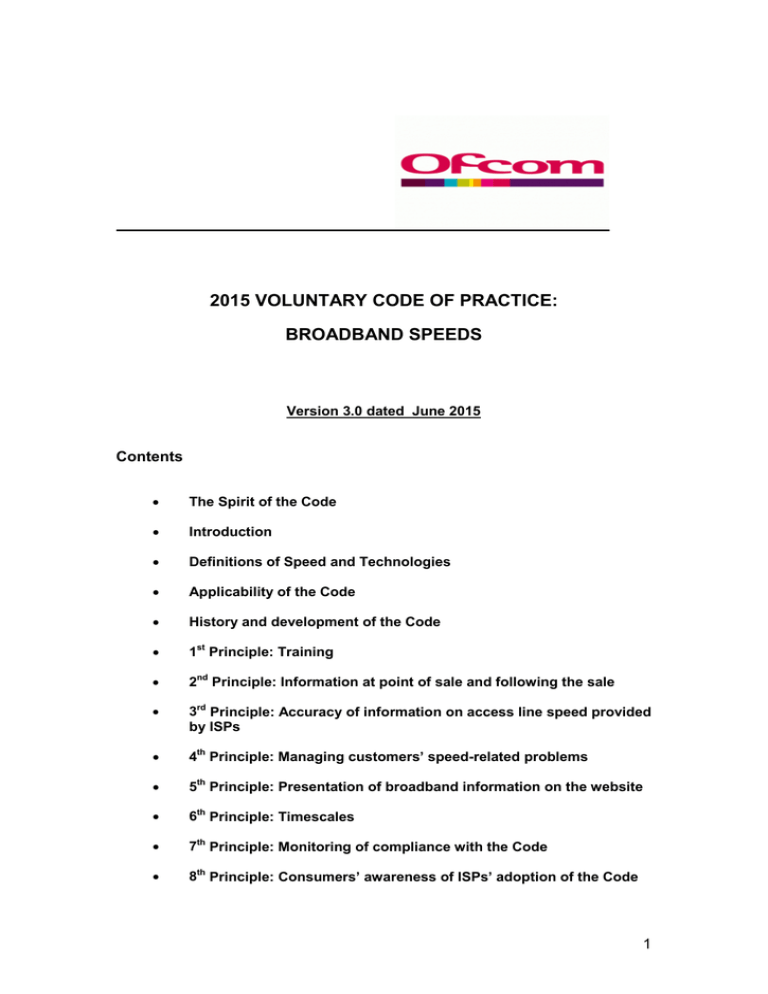
2015 VOLUNTARY CODE OF PRACTICE: BROADBAND SPEEDS Version 3.0 dated June 2015 Contents • The Spirit of the Code • Introduction • Definitions of Speed and Technologies • Applicability of the Code • History and development of the Code • 1st Principle: Training • 2nd Principle: Information at point of sale and following the sale • 3rd Principle: Accuracy of information on access line speed provided by ISPs • 4th Principle: Managing customers’ speed-related problems • 5th Principle: Presentation of broadband information on the website • 6th Principle: Timescales • 7th Principle: Monitoring of compliance with the Code • 8th Principle: Consumers’ awareness of ISPs’ adoption of the Code 1 The Spirit of the Code 1. Ofcom’s principal duty under the Communications Act 2003 is, in carrying out its functions, to further the interests of citizens in relation to communications matters and to further the interests of consumers in relevant markets, where appropriate by promoting competition, by having regard, in particular, to the interests of those consumers in respect of choice, price, quality of service and value for money. Ofcom is particularly required to secure the availability throughout the United Kingdom of a wide range of electronic communications services, which includes broadband services. 2. Ofcom is further to have regard, in all cases, to the principles under which regulatory activities should be transparent, accountable, proportionate, consistent and targeted only at cases in which action is needed and any other principles appearing to Ofcom to represent the best regulatory practice. Ofcom is also to have regard to, where it appears to it to be relevant in the circumstances, among other things: a. the desirability of promoting and facilitating the development and use of effective forms of self-regulation; b. the desirability of encouraging the availability and use of high speed data transfer services throughout the UK; and c. the opinions of consumers in relevant markets and of members of the public generally. 3. Indeed, this reflects Ofcom’s regulatory principles 1; those being of particular relevance to this Voluntary Code of Practice (“Code”) are that Ofcom will: a. operate with a bias against intervention, but with a willingness to intervene firmly, promptly and effectively where required; b. strive to ensure its interventions will be evidence-based, proportionate, consistent, accountable and transparent in both deliberation and outcome; and c. always seek the least intrusive regulatory mechanisms to achieve its policy objectives. 4. 1 In light of the above, Ofcom believes that the Code is appropriate as a voluntary and self-regulatory measure. Whilst recognising that speed is not the only criterion on which consumers base their broadband purchasing decisions, the objective of the Code is to increase the overall standard of information on broadband speeds – and other relevant metrics – that should be made available to consumers at point of sale to help them make more informed choices of service products offered in the broadband market. This is because broadband speeds is a particularly complex area for consumers, taking into consideration, for example, different technologies and access routes used by businesses providing consumers with connection to the internet (i.e. internet service providers or “ISPs”). http://www.ofcom.org.uk/about/what-is-ofcom/statutory-duties-and-regulatory-principles/ 2 5. While Ofcom considers that the Code is appropriate at this stage to deliver benefits to consumers, Ofcom will continue to monitor people’s experiences with matters covered by the Code, and we may introduce formal regulation if self-regulation does not appear, in Ofcom’s opinion, to satisfactorily address these issues or Ofcom otherwise considers that there is a need to intervene more promptly or effectively. 6. The spirit of the Code, the voluntary will and commitment by the ISPs to making self-regulation work, not just to the letter, is an essential element to its success. 7. Therefore, in honouring not only the letter but the full spirit of the Code, words, terms or provisions should not be so narrowly interpreted so as to compromise the ISPs’ commitments to give consumers adequate information on broadband speeds before consumers make a decision to purchase the ISPs’ services. Specifically, ISPs should use common sense in abiding by and interpreting the Code. In other words, Ofcom believes that the overall test should be whether, in the circumstances of each case, the ISPs are working within the spirit of the Code and are making every reasonable effort to comply with it. Their fullest co-operation with Ofcom also forms part of the spirit of the Code. 8. Specifically, Ofcom has sought to capture the ISPs’ commitments under eight principles within the Code. For the avoidance of doubt, those commitments are not seeking to duplicate or replace requirements under legislation or regulatory requirements imposed by Ofcom or otherwise; they are also without prejudice to compliance with such requirements. Introduction 9. When the Code was introduced in 2008, there was a noticeable trend for some ISPs to advertise their products based on faster and faster headline speeds 2. However, the evidence from Ofcom’s research 3 indicated that these headline speeds were rarely achievable in practice by the majority of consumers that bought them due to a number of factors, including the nature of the customer’s line, the capacity of ISPs’ networks, the number of subscribers sharing the network, and the number of people accessing a particular website at a particular time. 10. This disparity between actual throughput speeds 4 and headline speeds may have led to some consumers feeling confused and frustrated. With consumers’ interests in higher broadband speeds continuing to rise, in particular due to the increased take up of superfast broadband packages, it is important to remedy any mismatch in their expectations to avoid such confusion and frustration. 11. Ofcom believes that there are steps that ISPs can take to improve the information provided to consumers both before they sign up to a service and after they have had the opportunity to use the service. Ofcom introduced the 2 See “Definitions of Speed and Technologies” further below. http://www.ofcom.org.uk/research/telecoms/reports/broadband_speeds/broadband_speeds 4 See “Definitions of Speed and Technologies” further below. 3 3 Code 5 to encourage ISPs to provide consumers with more information at point of sale on the speeds they could expect to obtain from their broadband service. In particular, the Code requires ISPs to provide consumers with information on their access line speed 6 to help ensure that consumers choose the package that is the most appropriate for them in light of their individual circumstances and needs. 12. We believe that information on access line speeds benefits consumers because it will give them an expectation about the maximum speed achievable on their specific line (access line speeds depend closely on the particular technical characteristics of the line). 13. In addition to having information about access line speeds, consumers also benefit from having information about the actual throughput speeds which the particular ISP achieves – throughput speeds are an important metric for consumers since this is the download speed which they obtain in practice whilst using the internet. Different ISPs are likely to vary in their throughput speed performance as a result of a number of factors, such as the level of investment in their network capacity. Definitions of Speed and Technologies 14. It is useful to explain the different definitions of speed and technologies that are used in the Code, and in industry: Speed a. headline or advertised speed – This is the speed that ISPs use to describe the packages that they offer to consumers. They are often described as ‘up to’ speeds, but these are often only a guide as to the speed an ISP can provide and at what price; b. access line speed – This refers to the maximum speed of the data connection between the broadband modem and the local exchange or cable head end. This constitutes the maximum speed a consumer will be able to experience on his/her individual line; c. actual throughput (or download) speed – This is the actual speed that a consumer experiences at a particular time when they are connected to the internet. This figure is often dependent on factors such as the ISP’s network, its traffic shaping and management policy, the number of subscribers sharing the network and the number of people accessing a particular website at a particular time. d. average throughput (or download) speed – This is an average of actual throughput speed for each different broadband product offered by an ISP. Technologies 5 6 See “History and development of the Code” further below. See “Definitions of Speed and Technologies” further below. 4 a. Cable – Sometimes referred to as Hybrid Fibre Coaxial (HFC) networks, cable networks combine optical fibre and coaxial cable (a cable made up of a conductor and a tubular insulating layer) to carry TV and broadband signals to end-users; b. DSL (or Digital Subscriber Line) – a family of technologies generally referred to as DSL, or xDSL, capable of transforming ordinary phone lines (also known as ‘twisted copper pairs’) into high speed digital lines, capable of supporting advanced services such as fast internet access and video-on-demand. ADSL (Asymmetric Digital Subscriber line), HDSL (High Data Rate Digital Subscriber line) and FTTC are all variants of xDSL; c. FTTC (or Fibre to the Cabinet) – an access network consisting of optical fibre extending from the access node to the street cabinet. The street cabinet is usually located only a few hundred metres from the subscriber premises. The remaining segment of the access network from the cabinet to the customer is usually copper pair, but another technology such as wireless could be used; d. LTE (or Long-Term Evolution) – is a standard for communication of high-speed data for mobile phones and data terminals; e. Satellite – satellite broadband is a data service where satellites are used to provide the wireless data connectivity. A satellite dish at the customer’s premises connects to a geostationary satellite and transmits signals through the air; f. VDSL (or Very high data rate digital subscriber line) – a digital technology that allows the use of a standard telephone line to provide very high speed data communications, which is used in fibre-to-thecabinet deployments; g. WiMAX – A wireless MAN (metropolitan area network) technology, based on the 802.16 standard. It can be used for both fixed and mobile data applications. Applicability of the Code 15. The Code applies to all fixed access broadband ISPs who sign up to the Code (the “signatories”). A list of the signatories is kept on Ofcom’s website (www.ofcom.org.uk) and will be updated by Ofcom from time to time, as appropriate. The Code applies to the sale of residential products, including contract upgrades/downgrades from the effective date onwards. The Code does not apply to dedicated business products intended primarily for use by business customers. However, all residential products (which are used, in some cases, by small businesses) will be covered by the Code. 16. Ofcom also notes that some of the principles of the Code are not relevant to all technologies used in supplying fixed access broadband services. For example, on cable networks, the access line speed is expected to be consistent with the headline speed. Other principles in the Code will apply to all ISP signatories, regardless of the access line technology. 5 History and development of the Code 17. The Code was first introduced on 5 June 2008 and had to be implemented by the initial signatories by 5 December 2008. In late 2009 we undertook mystery shopping research (which was published in March 2010 7) to ascertain whether and to what extent signatories were complying with the Code. The results suggested that although more information on broadband speeds was being provided by ISPs, insufficient information was often still provided to allow consumers to have clear expectations about the broadband service they sign up to. We noted in the market research report that we would seek to agree changes to the Code with ISPs to address the issues revealed by the research; for further information, please see the report 8. 18. The Code was subsequently revised in 2010 following the evaluation of the mystery shopping research and further work on the calculation and presentation of access line speed estimates. 19. Ofcom also updated the Code to include additional commitments from ISPs to provide estimates in the form of a range and to give consumers the right to exit their contract without penalty within a three-month period of the start of their contract (or longer if the ISP so chose) if the actual speed was significantly below the estimated speed. 20. Since then, the market has been developing rapidly with more consumers taking up superfast broadband services and broadband delivered via fixed wireless technology. In addition, Ofcom has undertaken mystery shopping research to measure compliance with the Code. As a result of these, Ofcom believes it is appropriate to further revise the Code. The introductory sections to the Code have also been updated. 21. In summary, this version of the Code has been updated to include the following: • • • • • • 7 8 Require speed estimates to be provided in the form of a range by ISPs providing FTTC/VDSL and fixed broadband delivered via fixed wireless technology (such as WiMAX, satellite and LTE). Specify that the Code applies to the sale of residential products, including upgrades/downgrades from the effective date of this Code onwards. Focus the type of information required to be given at point of sale to the key information which would allow a consumer to make an informed choice about the proposed broadband service before entering into a contract. Specify information which is relevant to a customer’s use of the broadband service to be provided following the sale (including information given about speeds at point of sale and the additional post-sale information specified below). Require ISPs to provide the above information in after sales correspondence (via letter, email and/or in My Account) as soon as possible after the sale has been concluded (and in any event within 7 calendar days), and to set this out clearly in plain English and in an easy to read format. If a customer requests further information on any of these issues at the point of sale, ISPs should provide further explanation at that point. See http://www.ofcom.org.uk/telecoms/ioi/copbb/voluntary_code_copbb/. http://stakeholders.ofcom.org.uk/binaries/telecoms/cop/Synovate_report.pdf 6 • • • • • For information on traffic management and fair usage, an ISP should provide guidance in the follow up literature in plain English, including links to website information if an ISP applies such policies. Replace the requirement on ISPs using technologies such as cable to indicate the likely throughput speed during peak times to a requirement on all ISPs, regardless of technology, to provide information in the follow-up literature explaining the factors which may cause peak time congestion. Extend the arrangements set out in the 4th Principle of the code to apply throughout the full duration of a customer’s contract period. Explain how Ofcom will act in cases of non-compliance with the Code. Include definitions of the technologies covered by the Code. 22. The operation and application of the Code will continue to be subject to review by Ofcom from time to time in consultation with the signatories and other relevant stakeholders, so that we can ensure it continues to serve the interests of citizens and consumers and so that any new developments within the market can be reflected in the Code if appropriate. Some of the provisions within the Code are designed to address the issue of consumers having expectations of their speed which are in excess of the speeds being delivered. This possible mismatch of expectations results, in part, from the way in which broadband has been advertised. Some of the provisions in the Code may therefore be less relevant where an ISP uses indicators other than speed to explain broadband performance. Ofcom will therefore work with ISPs to consider whether and how the Code needs to be adapted so that consumers are still given clear information on performance as the way in which broadband is promoted and sold changes. 7 The Principles of the Code 1st Principle: Training 23. ISPs must use their best endeavours to procure that all of their representatives (including all of their officers and employees and any agents or sub-contractors) (“Representatives”) involved in selling or promoting their broadband products and services or in the renewal or extension of agreements of existing customers are trained appropriately and that they have sufficient understanding of the products and services they are promoting and selling. 24. This commitment includes that ISPs are satisfied that any related training processes provide their Representatives with sufficient preparation to implement and apply the Principles of the Code. 25. This commitment also includes Representatives’ attention being fully drawn to the Code, including the philosophy and spirit of the Code as explained in the preamble. 2nd Principle: Information at point of sale and following the sale 26. It is an essential cornerstone of the Code that consumers 9 can make informed choices about the type of service they are likely to receive upon entering into any contracts with the ISPs. 27. To achieve this Principle, ISPs must use their best endeavours to procure that all of their Representatives take the following steps contained in this Principle to ensure that accurate and meaningful information on broadband speeds is provided to consumers before they enter into any contract or, in the case of existing customers, where their package is upgraded/downgraded. ISPs and their Representatives must also ensure that consumers are made aware that there is additional information on the particular broadband service provided on the ISPs’ websites, including that referred to in the 5th Principle below, and that further information will be provided in the introduction/starter pack provided either by letter, email and/or posted in “My Account” (if such a facility is provided) after a sale has been made. 28. For those ISPs using technologies such as DSL, FTTC/VDSL or fixed broadband delivered via fixed wireless (such as WiMAX, satellite or LTE), for which the access line speed can be lower than the headline speed, ISPs and their Representatives must: a. Provide all consumers as early as practicable within the sales process, and in any event before consumers are asked for personal financial details, with information on their estimated access line speed in accordance with sub-paragraph (c), regardless of whether this is conducted over the phone, in a retail shop or through the ISP’s website. The sales process commences as soon as consumers are asked to input or provide any personal information (such as their 9 The expression “consumers” as used throughout the Code has the meaning given in section 405(5) of the Communications Act 2003. 8 address or landline number), regardless of the channel by which the customer chooses to engage with the ISP. Where a consumer starts the sales process on one channel and is subsequently directed by the ISP to another channel to progress or complete the transaction, ISPs should provide information on the estimated access line speed on each channel. b. Provide a facility (line/speed checker) on their website so that consumers can find out, in a clear and easily accessible manner, what their estimated access line speed will be if they choose to purchase that service. ISPs must ensure that access line speed information is given due prominence on the line/speed checker speed results webpage (i.e. the page on which a consumer’s access line speed estimate is generated following the input of a consumer’s postcode and/or landline number). For example, ISPs should underline or embolden the estimated figure. c. Ensure that the access line speed information provided within the sales process is provided in the form of a range which is equivalent to the access line speeds achieved by the 20th to 80th percentiles of the ISP’s similar customers (i.e. customers with similar line characteristics and who are on broadband packages of the same headline speed as the customer is enquiring about).The ISP should also explain to the consumer that the range of access line speeds provided is only an estimate and that if the consumer receives an access line speed which is significantly below this range then the customer should contact the ISP. If asked to explain further or asked to state the definition of “significantly below”, the ISP should provide information on the access line speed achieved by the bottom 10th percentile (or above) of the ISP’s similar customers (“the minimum guaranteed access line speed”) and explain that if the customer’s actual access line speed is below the minimum guaranteed access line speed, then it will follow the process set out in the 4th Principle. ISPs may supplement the range provided with an additional single-point estimate within the range which is no higher than the median access line speed achieved by the ISP’s similar customers. ISPs may adopt an alternative approach to calculating the range to that set out above if the ISP is able to demonstrate that this approach provides a more accurate estimate of customers’ access line speeds. Any alternative approach used by the ISP must provide a narrower range than using the approach set out above, result in at least 60% of customers achieving an access line speed within the range provided and must be set such that, in cases where customers’ actual access line speeds fall outside the range provided, fewer customers’ actual access line speeds lie below the bottom of range provided than lie above the top of the range. In using an alternative approach, ISPs may supplement the range provided with an additional single-point estimate provided that this estimate is the arithmetic mean of the top and bottom of the range. Regardless of which of the above two approaches is used to calculate the range, the ISP may, where the size of the calculated range is 2Mbit/s or less, provide the customer with a single-point estimate 9 instead of the range provided that the customer is informed that the single point estimate is only likely to be accurate within +/-1Mbit/s . d. Ensure that consumers will only be able to complete an order online, over the phone or through a retail shop when they have been given the estimate of the range within which their access line speed is likely to fall. In the exceptional circumstance where the relevant line information is not available to ISPs, this condition will not apply for customers who expressly do not wish to have a speed estimate. 29. During the sales process and regardless of the technology used, ISPs and their Representatives must: a. In addition to the access line speeds information provided in accordance with paragraph 28 (where applicable), provide information on the actual throughput speeds customers are likely to receive under normal circumstances, if available; b. explain to the consumer in a clear and meaningful way (i) that the actual throughput speed experienced by a consumer will be influenced by a number of factors and may be lower than the estimated access line speed (where relevant). ISPs must specifically explain, where a traffic management policy applies, what this means for the consumer and how their speeds may be affected, and where a fair usage policy applies, what this means for the consumer, how their use of the service may be affected and setting out any specific usage limits. c. ISPs should explain that information on estimated speeds, how speeds may be affected and what the consumer can do if they experience problems will be set out in more detail in the introduction/starter pack which will be provided following the sale. The ISP should specify whether this information will be made available by letter, email and/or posted in “My Account”. d. Should a customer request further information on any issue at the point of sale, the ISP should provide further explanation. Where the transaction is online, all appropriate information should be available to consumers during the sales process.. 30. After the customer has placed the order, the ISP must provide the customer, either by letter, email and/or in “My Account” (in the latter case, notifying them when they have done so), an introduction/starter pack which includes at least the following information: a. for DSL, FTTC/VDSL and fixed broadband delivered via fixed wireless services, ISPs must state the estimated access line speed range, the minimum guaranteed access line speed and, where provided by the ISP to the customer during the sales process, the single-point estimate; b. ISPs must provide an explanation that certain factors may affect the actual throughput speed experienced by a consumer, including: i. the nature of the customer’s line; 10 ii. the ISP’s network capacity; iii. the number of subscribers sharing the network; iv. the ISP’s traffic shaping and management policy; v. the number of subscribers online and accessing a particular website at any one time, by time of day, etc; c. ISPs must also provide an explanation of the factors which may cause peak time congestion, such as high usage due to major sporting events; d. The ISP must give equal prominence to the fact the customers will have the ability to leave their contract without penalty if: i. The customer receives an access line speed which is below the minimum guaranteed access line speed; and ii. The measures set out in the 4th principle have been taken but the issue has not been resolved. This right does not affect the customer’s statutory or contractual rights. e. ISPs may set out any other remedies available to the customer in line with the 4th principle where offered by the ISP. f. where applicable, ISPs must provide information on any fair usage policies – explaining what fair usage means, how this may affect the customer’s use of the service and setting out any specific usage limits which apply – and including, where appropriate, weblinks to the information set out in the 5th Principle below; g. where applicable, ISPs must provide information on traffic management policies – explaining what traffic management means and how the customer’s speeds may be affected – and including, where appropriate, weblinks to the information set out in the 5th Principle below; and h. ISPs must provide information about the Code in accordance with the 8th Principle below. 31. The information set out in paragraph 30 should be sent as soon as possible after the sale has been concluded, and in any event within the 7 days of the transaction date. 32. ISPs and their Representatives must be sensitive to and take reasonable steps to accommodate the needs of vulnerable consumers or consumers that otherwise appear uninformed about the ISP’s services or products, e.g. those who are elderly or whose first language is not English. 3rd Principle: Accuracy of information on access line speed provided by ISPs 33. Another important principle of the Code is that the information initially provided by the ISPs to consumers at point of sale is as accurate as possible. This Principle applies for all technologies. 11 34. To achieve this Principle, ISPs must use their best endeavours to implement the following measures to ensure that information is kept up to date and as close to consumers’ experiences as possible. The following will only apply for technologies such as DSL, FTTC/VDSL, or fixed broadband delivered via fixed wireless, where the access line speed can be lower than the headline speed. a. ISPs must take all reasonable steps to ensure, where applicable, that access line speed information provided at point of sale is as accurate as possible and is updated to reflect any changes to or new information on the line. b. Ofcom recognises that some estimates of access line speed provided to consumers by ISPs are dependent on third party wholesale providers. Ofcom will work with ISPs and the relevant wholesale providers to ensure that appropriate steps can be taken to address the accuracy of information, and, in particular, to ensure ISPs are able to comply with this revised version of the Code in line with the timescales set out below. Implementation dates from those ISPs that choose to use BT Wholesale for access line speed estimates will be dependent on BT Wholesale making the necessary changes to its systems. We expect that ISPs will, where possible, make the necessary changes to their own systems in parallel to minimise the delay in implementation. c. In order that Ofcom can have confidence in the accuracy of information provided to consumers, ISPs will work with Ofcom to verify the overall quality of this information. Ofcom will continue to work with ISPs and wholesale providers to improve the accuracy of the methodologies used by ISPs to estimate the access line speeds given to customers. 4th Principle: Managing customers’ speed related problems 35. ISPs must be prepared to manage customers’ problems when they report that they are not receiving the speeds that they had expected to receive when they purchased the broadband service. 36. To achieve this Principle, ISP must ensure the following: a. Those ISPs using technologies such as DSL, FTTC/VDSL or fixed broadband delivered via fixed wireless, for which the access line speed can be lower than the headline speed must: i. Have a robust process in place for identifying whether the problem relates to a slower than expected access line speed; ii. Log the problem as a technical fault if the actual access line speed is at or below the minimum guaranteed access line speed, or if it is otherwise appropriate to do so. As soon as possible after the problem is logged as a technical fault, the ISP must tell the customer their minimum guaranteed access line speed and explain that if the technical fault cannot be fixed then the customer will have the opportunity to leave their contract immediately and without any penalty. The ISP must then take steps to ensure the fault is corrected; 12 iii. If it appears from the diagnostics that the problem is likely to have resulted from factors within the customer's control, e.g. internal wiring, the ISP should advise the customer of that fact and provide assistance to alleviate the problem as soon as possible; iv. If, following notification of the fault to the ISP, the ISP has taken all reasonable steps to ensure the fault is corrected (including those set out above), and the customer has implemented the measures advised by the ISP but continues to receive an access line speed below the minimum guaranteed access line speed then the ISP must offer the customer the opportunity to leave their contract immediately, and without penalty. v. In the event that the customer continues to receive an access line speed at or below the minimum guaranteed access line speed, it is open to the ISP to offer other remedies in addition to the right to leave the contract set out above. For example, ISPs may agree with the customer that the customer can remain on their existing service but will pay the equivalent contract fee to a lower speeds package that is closer to the actual speed being achieved. Regardless of whether the ISPs offer this option or any other remedy to customers, they must always offer the customer the opportunity to leave their contract immediately, and without penalty. b. Regardless of the technology used, ISPs must: i. Have a robust process for identifying whether the cause of the speed related problem is within the ISP’s control and, where it is not, to explain clearly to the customer the possible causes of the lower speeds and how such problems could be addressed. ii. Where the cause of the problem is within the ISP’s control, to monitor the problem through to resolution or until reasonable remedial actions are exhausted or the customer is satisfied with the outcome. c. Ensure that these processes are clearly highlighted on a prominent position on the ISP’s website or in the introduction/starter pack that typically accompanies a customer’s provision of service. 5th Principle: Presentation of broadband information on the website 37. The purpose of this Principle is to supplement and, where appropriate, extend the 2nd Principle of the Code. 38. ISPs should explain, in a prominent place on their websites, how customers can check the access line speed and actual throughput speed they are receiving in practice. 13 39. ISPs should also provide information on their websites which clearly explains to customers what steps they can take to ensure that they receive the highest possible access line speeds and actual throughput speeds. 40. ISPs must also set out clearly, and in a prominent place on their websites (e.g. within “Help” or “FAQs” sections), information relating to their respective policies on fair usage; traffic management and traffic shaping to cover, at a minimum, the matters set out below. Information should be written in plain English and be clear and comprehensive to consumers. Fair usage policies and usage limits 41. ISPs should publish, in a clear and easily accessible form, any criteria they use for determining breaches of its fair usage policy (e.g. total usage, specific percentage of users, etc). ISPs whose fair usage policy is breached when a specific usage limit is reached should set out that limit. ISPs with a fair usage policy should set out in their policy an indication of the approximate level of usage which is likely to trigger a breach of the policy, e.g. the average level of usage in the past six months that has triggered a breach of the fair usage policy. If an ISP has a fair usage policy, this should be set out at the point of sale and in the introduction/starter pack, in accordance with the 2nd Principle above. 42. ISPs should publish, in clear and easily accessible form, the actions they intend to take should a user exceed a usage limit or breach a fair usage policy (e.g. the size of any extra charges or nature of any speed restrictions, etc). 43. Where it is reasonably possible to do so, ISPs should provide a means by which users can measure their total usage over the relevant billing period or indicate to customers how they can do so. 44. ISPs in possession of a user’s email address should provide users with email notification when users exceed a usage limit or breach a fair usage policy which informs users about the precise consequences of doing so, e.g. additional costs, information on speed restrictions imposed, etc. 45. ISPs should also consider providing advance notification to subscribers approaching a usage limit. Traffic management and traffic shaping 46. Where ISPs apply traffic management and shaping policies, they should publish on their website, in a clear and easily accessible form, information on the restrictions applied. This should include the types of applications, services and protocols that are affected and specific information on peak traffic periods. 47. If an ISP has a traffic management policy , they should set this out at the point of sale and in the introduction/starter pack, in accordance with the 2nd Principle above. 6th Principle: Timescales 14 48. This Version 3.0 of the Code will come into effect on 1 October 2015. ISPs should seek to implement the Code in full by 1 October 2015, and in any event, by 31 January 2016, which is the end of the transitional period. In order that consumers are aware which ISPs are complying with the Code, Ofcom will publish on its website the current list of signatories. 49. Version 1.0 or 2.0 will no longer apply from 31 January 2016. ISPs who wish to be signatories to the Code will need to comply with all the provisions of this Version 3.0. 7th Principle: Monitoring of compliance with the Code 50. The preamble to the Code explains that the ISPs’ fullest co-operation with Ofcom forms part of the spirit of the Code. This commitment includes the ISPs providing Ofcom with appropriate information, in writing or otherwise, as to their compliance with the Code on Ofcom’s request, and by no later than the reasonable deadlines for responses as set by Ofcom from time to time. ISPs must confirm to Ofcom when they have implemented all of the provisions in the Code in full. 51. Ofcom intends to monitor compliance with the Code through a number of methods including, but not limited to, carrying out regular mystery shopping exercises by Ofcom itself or its agents. Ofcom may itself or through its agents also undertake audits, for example, using ISPs’ actual sales calls to assess whether ISPs are giving consumers the information required by the Code. The results of any research or audits undertaken to monitor compliance will, where appropriate, be published on a provider-specific basis. 52. Ofcom will examine matters of possible non-compliance on a case-by-case basis. Where we consider that an ISP may have breached a requirement of this Code, we will write to them, setting out where we consider that they are non-compliant, seeking representations and requesting the ISP to take steps to address compliance issues. Ofcom may, where it considers it appropriate to do so, remove signatories from the Code. For example, removal may be appropriate as a result of persistent non-compliance following requests from Ofcom for an ISP to address compliance failures (for example, the requirement to provide a speed/line checker). In cases which we consider removal from the Code to be an appropriate course of action, we will notify the ISP. If the ISP takes steps to comply with the Code, the ISP may continue to be a signatory. Should an ISP be removed from the Code and subsequently take steps to comply with the Code, they may be reinstated upon written request to Ofcom. This is without prejudice to any other action under, for example, relevant consumer laws. 8th Principle: Consumers’ awareness of ISPs’ adoption of the Code 53. Information on the Code should be given to customers in the introduction/starter pack provided either by letter, email and/or posted in “My Account” when they sign up. As a minimum this must include information about membership of the Code and what it means for consumers. 54. ISPs must also provide a full copy of the Code through an easily accessible link on their respective website. 15 16

